Mongan, Deirdre (2016) Health behaviour in school-aged children, 2014. Drugnet Ireland, Issue 56, Winter 2016, pp. 14-16.
| Preview | Title | Contact |
|---|---|---|
|
PDF (Drugnet 56)
653kB |
The first Health Behaviour in School-Aged Children (HBSC) was conducted in Ireland in 1998 and has been repeated every four years since. In 2014 Ireland participated for the fifth time in the HBSC study. The survey included 13,611 school-children drawn from 3rd class in primary school through to 5th year in post-primary school; 230 primary and post-primary schools across Ireland participated. Data were collected on general health, smoking, use of alcohol and other substances, food and dietary behaviour, exercise and physical activity, self-care, injuries, bullying and sexual health behaviours. The main results were published in December 2015.1
This article describes the results pertaining to the use of alcohol and other substances, which were reported in the main report, and makes comparisons with the previous HBSC surveys. It also includes a more in-depth analysis of alcohol and cannabis use, which was prepared by the HBSC at the Health Research Board’s request.2
Alcohol
Overall, 51 per cent of 13–17-year -olds reported that they had ever had an alcoholic drink. Use of alcohol increased with each year of age and, with the exception of 17-year-olds, boys were more likely than girls to have ever drunk an alcoholic drink (Figure 1).
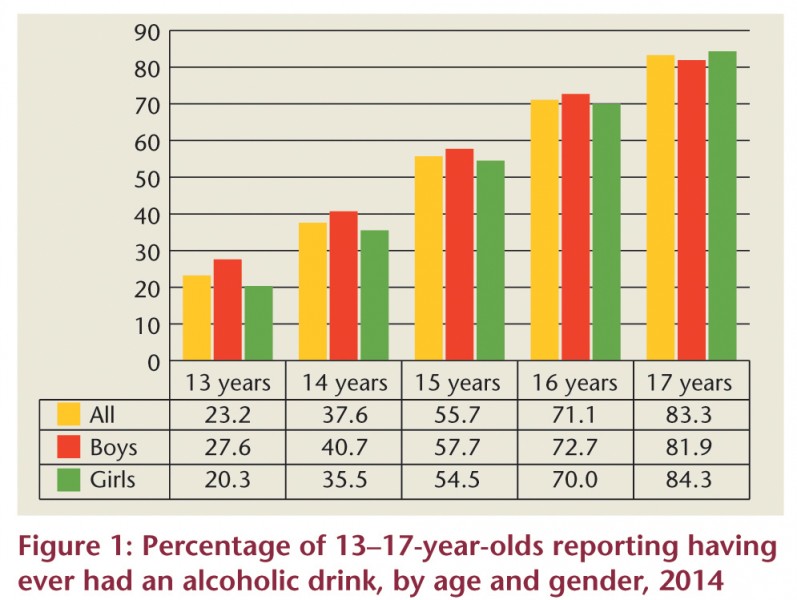
Almost one in five 13–17-year-olds (19.3%) reported that they had drunk alcohol in the last 30 days. A higher proportion of boys in all age groups (except for 17-year-olds) reported drinking in the last 30 days, compared to girls (Table 1).
Table 1 Percentage of 13–17-year-olds reporting having had an alcoholic drink in the past month, by age and gender, 2014
|
Age |
All |
Boys |
Girls |
|
13 years |
4.9 |
6.1 |
4.2 |
|
14 years |
12.9 |
13.6 |
12.4 |
|
15 years |
24.1 |
25.5 |
23.2 |
|
16 years |
42.7 |
43.4 |
42.2 |
|
17 years |
61.1 |
57.7 |
63.7 |
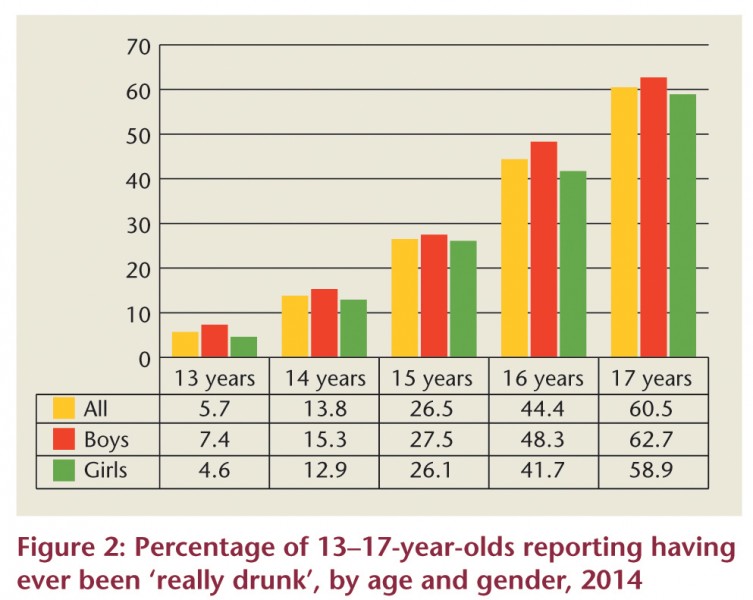
Over one-quarter of 13–17-year-olds (26.6%) reported that they had ever been ‘really drunk’. For each age, boys were more likely than girls to report lifetime drunkenness (Figure 2).
Cannabis
The majority of 13–17-year-olds (90.1%) reported that they had never used cannabis. Just under 10 per cent reported having used cannabis in the last 12 months. Cannabis use increased with each year of age and was more common among boys (Figure 3). There were no statistically significant social class differences.
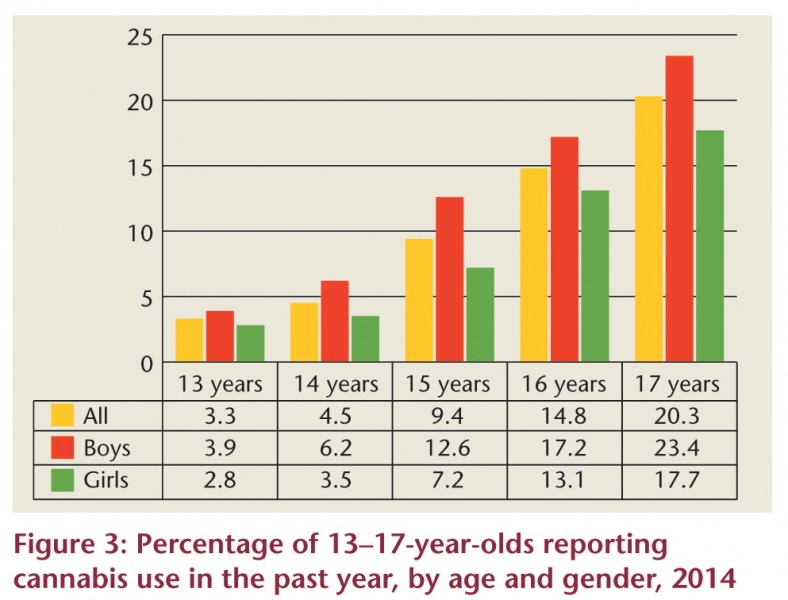
Overall, in 2014 one in twenty (5%) school-aged children reported using cannabis in the last 30 days.
Table 2 Percentage of 13–17-year-olds reporting use of cannabis in the last 30 days, by age and gender, 2014
|
Age |
All |
Boys |
Girls |
|
13 years |
0.9 |
1.1 |
0.7 |
|
14 years |
2.6 |
3.0 |
2.4 |
|
15 years |
6.7 |
8.8 |
5.2 |
|
16 years |
9.0 |
11.3 |
7.3 |
|
17 years |
11.0 |
13.8 |
8.8 |
Trends in alcohol and cannabis use among Irish school-aged children, 1998–2014
The percentage of school-aged children reporting having ever had an alcoholic drink has decreased steadily since 1998, especially among 13–15-year-olds (Figure 4). In 1998, 65.6 per cent of 13–year-olds and 72 per cent of 14–year-olds had ever consumed alcohol, compared to 23.2 per cent and 37.6 per cent respectively in 2014. However, the incidence of alcohol use among 17-year-olds remained consistent throughout the five time periods.
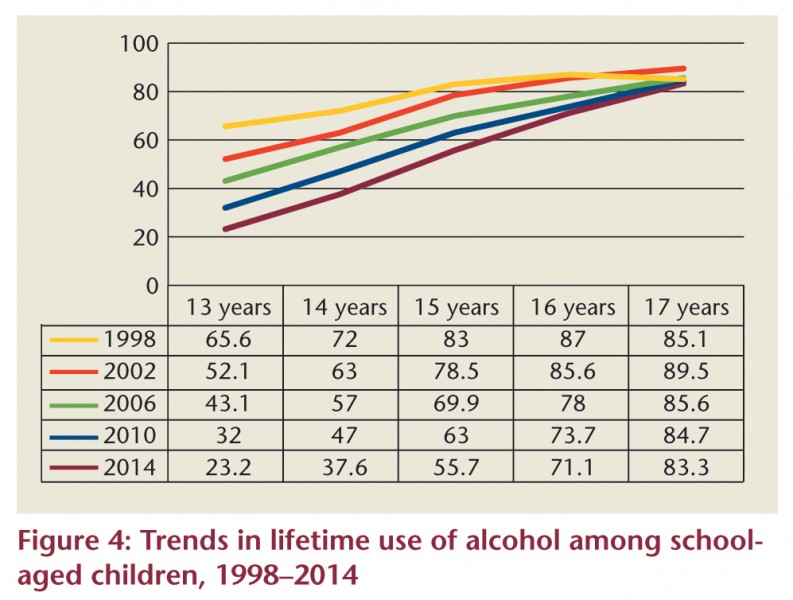
Levels of lifetime drunkenness have also decreased and this is most apparent among 13–15-year-olds. There is less variation among 17-year-olds (Figure 5).
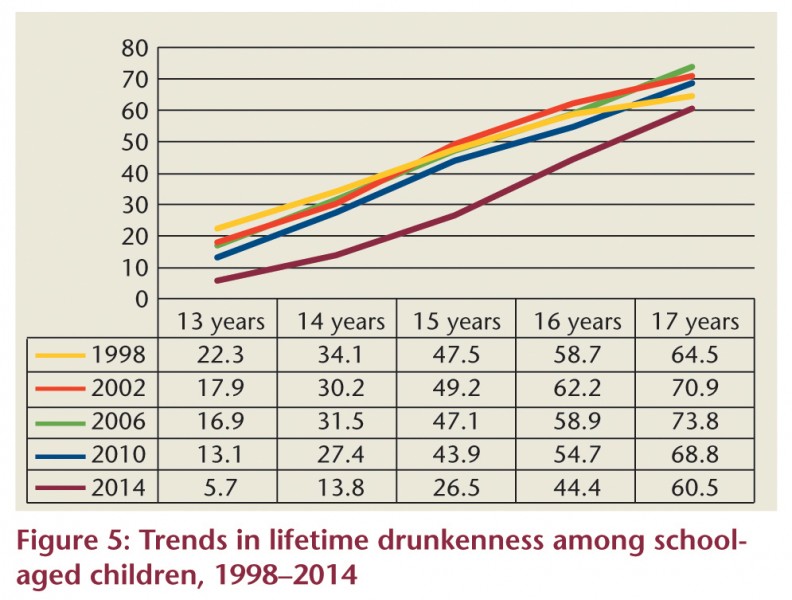
Similar to alcohol, there has been a steady decrease in the lifetime use of cannabis among 13–17-year-olds. This decrease can be observed across all ages (Figure 6).
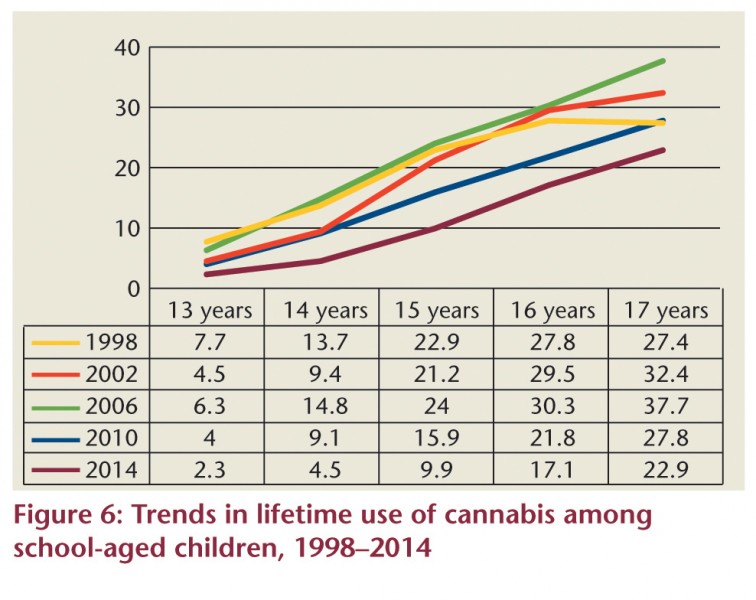
Overall, there was a decrease in self-reported alcohol and cannabis use among school-aged children in Ireland in 2014 when compared to 2010 and earlier surveys. This may represent a true decrease, possibly owing to children having less pocket money in recent years because of the recession, or it may be the result of sampling variation, or a combination of both factors.
These decreases are welcome, especially among younger teenagers, as the immaturity of their brains makes them particularly vulnerable to the harmful effects of alcohol. Delaying initiation of drinking also decreases the likelihood of developing alcohol dependence in later life. However, it is important to note that substance use is still common among Irish school-aged children, with one in five 17-year-olds using cannabis in the previous year and 60.5 per cent having ever been drunk. Efforts to reduce Irish school children’s substance use need to continue.
- Gavin A, Keane E, Callaghan M, et al. (2015) The Irish Health Behaviour in School-aged Children (HBSC) study 2014. Dublin: Department of Health and National University of Ireland, Galway. www.drugsandalcohol.ie/24909
- Perry C, Keane E and Nic Gabhainn S (2015) Short report HBSC Ireland 2014. Alcohol and cannabis use in school-children in Ireland. Galway: Health Promotion Research Centre, National University of Ireland, Galway. https://www.drugsandalcohol.ie/25969/
A Substance use and dependence > Prevalence > Substance use behaviour > Alcohol consumption
B Substances > Cannabis / Marijuana
B Substances > Alcohol
T Demographic characteristics > Child / children
T Demographic characteristics > Adolescent / youth (teenager / young person)
T Demographic characteristics > Student (secondary level)
VA Geographic area > Europe > Ireland
Repository Staff Only: item control page